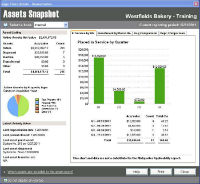ERP Implementation Partner Selection Tips and eBook
How to Find the Right ERP Implementation Partner Working with the right ERP implementation partner will be critical to the success of your ERP...
3 min read
Annette Manias Thu, May 14, 2015

In part 1 of this blog series "Fixed Asset Management Software: No More Spreadsheets! Part 1" we covered two main disadvantages to using spreadsheets to track your assets. In this blog we will discuss two inventory system practices for fixed asset management. The two inventory methodologies that most small to midmarket companies apply are the periodic method and the perpetual method. Smaller companies will discover definite assistance running a periodic inventory system, with periodic physical inventory count being concluded to apprise the asset accounting. While middle-market businesses may realize this technique less efficient and effective. The perpetual inventory system, continually records and brings up-to-date the activities and procedures of any given equipment or furnishing. Please let us know if you have a fixed assets question or topic that you’d like more information on.
The strategic element of fixed asset management is the inventory system. How properties, machinery and furnishings are marked, recognized, cataloged and charted can make a foremost transformation in how an organization manages their operations. Knowing where the proper equipment is at any given time is imperative, especially on important projects. Sustaining a robust inventory can make overall management run effortlessly and increase proficiency and efficiency at a basic level. There are diverse methods to inventory these items, and these should be taken into contemplation as the company continues to grow. Whatever optimal decision and choice is finalized, with flexible asset inventory software platform, a business can mature and continue to maintain a strong control on both the goods on hand and the bottom line profits.
There are two prevalent inventory systems in place, typically decided by modernizing procedures and processes. The first is the periodic method. As discussed previously, periodic inventory is a tactic in which asset accounting is finished only during a physical inventory count, which occurs on a scheduled if occasional basis. The count will typically necessitate a brief operational stoppage while employees scan tags to detect the position and integer of a particular asset.
In small companies, physical inventory counts commonly require a smaller amount of time and may only require a couple of employees in a specified length of time. However, with larger organizations, the volume of staff necessary and resources that must appraise will determine an interruption of the firm’s procedures while the entirety is reviewed to confirm their status and location.
Of course there are positive results to administering a periodic inventory system. In smaller firms that may only have one office or warehouse to work with, this system is extremely advantageous. They don't need as much data or information on their equipment, since they're likely using it daily for regular operations. Plus, the procedure doesn't take as much exertion to finalize.
Mid-sized organizations that have numerous offices or distribution centers may find the inventory method to be unproductive. Recurrent work stoppages to complete a physical inventory count may disturb operations. Also, there is a likelihood that mistakes or discrepancies will emerge that have to be tended to. For example, if equipment was acknowledged as outdated or no longer viable, these have to be quickly written off before remaining onward. This can make the process prone to errors and costly.
The other method of providing inventory for accounting and other purposes is the perpetual inventory system. In this instance, rather than running a comprehensive count sporadically to evaluate what fixed assets are obtainable, the activities and consumption of any given equipment or furnishing are consistently logged and updated. In addition, whenever property is attained, sold, reassigned or disposed of, this data is conveyed almost instantaneously with the pertinent modifications in asset accounting made afterward. This system is not always 100-percent precise or opportune, since there may be some intervals in updating the system. Checking the book balances are still a requirement, particularly when item whereabouts go unrecorded or on occasion, theft.
For many small-to-midsized companies, perpetual inventory systems are the greatest answer for handling fixed assets. There is a constant logic of where equipment is located, as well as the value of the items listed in the inventory if necessary. Additionally, any fluctuations can be updated in real time, saving the stress on making sure the numbers are correct. However, using this system requires significant investment in data capture, including readers and tags to be affixed to each furnishing, machine or vehicle that needs it. Also, physical inventory counts are still obligatory to keep a completely precise valuation of a company's holdings, even if they are less frequent. Still, with inventory asset management software, these practices are streamlined.
You can read more about Fixed Assets here, or you can contact us for a demo or pricing.
If you have any questions or need help with the above recommendations, please call tech support at 502-429-6902 x227.
Oasis Solutions Group provides consulting, implementation, support and project management services for Sage ERP 100 & 500 (F/K/A MAS 90 & 200), CRM (Customer Relationship Management) and HRMS software. Oasis provides and supports on-premise and cloud-based software products.
Located in Louisville, KY, Lexington, KY and Nashville, TN, we cover the Mid-West and New England areas as well as other locations.
We provide telephone, remote and on-premise support. In addition, we work with companies who purchased the system and need a higher level of expertise and support than they are receiving.
Another version of this blog was posted on Mar 17, 2015 on Oasis Blog: Why You Should Avoid Using Spreadsheets for Fixed Asset Management, Part 2
Topics: Fixed Asset Management, spreadsheets, sage fixed assets, inventory management
How to Find the Right ERP Implementation Partner Working with the right ERP implementation partner will be critical to the success of your ERP...

3 Tips for Finding the Best ERP Manufacturing Software for Your Business If your manufacturing company is outgrowing your software the search for...

Grow Your Business with a New Manufacturing ERP Solution The economy is constantly changing, and manufacturing companies have been hit hard by recent...